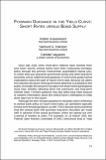Artículo
Forward guidance in hte yield curve: short rates versis bond supply
Fecha
2016Resumen
Since late 2008 when short-term interest rates reached their zero lower bound central banks have been conducting monetary policy through two primary instruments: quantitative easing (QE) in which they buy long-term government bonds and other long-term securities and so-called forward guidance in which they guide market expectations about the path of future short rates. Because QE alters the maturity structure of the government debt that is available to the public it changes the amount of duration risk that market participants must bear thereby affecting bond risk premiums and long-term interest rates. Forward guidance may also affect long rates because it contains information about the central bank’s willingness to keep short rates low in the future.
Colecciones
Descargar


